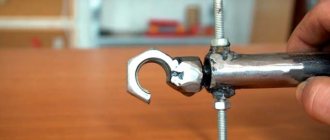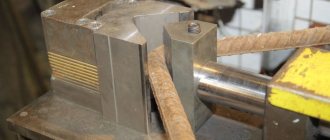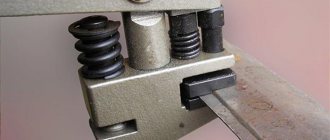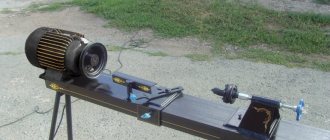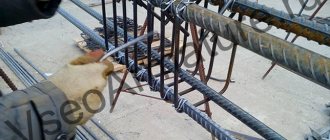Today, not a single construction project can do without reinforcement. The strength and reliability of metal rods significantly improve the characteristics of concrete, allowing it to last for decades, withstanding any load. But in order to knit a reliable frame from rods, you need a hook for tying reinforcement; you can buy it in a store or make it yourself.
Types of tools for knitting reinforcement
The knitting method involves using steel wire to manually fix rods perpendicular to each other in places where they intersect crosswise.
A crochet hook is a simple and safe tool that allows you to tie reinforcement bars quickly, securely and evenly.
Today, there are three types of ready-made hooks for knitting reinforcement bars, which can be purchased in the store. In addition, you can make a hook for the reinforcement yourself.
Manual
Photo of a purchased hook. The handle rotates freely.
A simple hook is a rod attached to a handle with bends that grip the wire. The hook for tying the reinforcement is rotated manually. The advantage of hand tools is their availability, durability and ease of use.
A hand crochet hook is an excellent option for novice builders, which will allow you to understand the knitting algorithm and feel the optimal degree of wire tension to obtain high-quality knots.
Screw
The knitting wire is selected with a diameter from 0.8 to 2 mm.
A semi-automatic hook is a reversible tool that operates by forward movements of the handle. The device has a rod with a hook in the form of a drill, which fits into the funnel of the handle along the thread, tightening the wire.
The cost of such a tool is higher than a manual one. But the screw tool makes it possible to cope with a wide range of work in a short time - in order to completely tighten the knot, it is enough to make only a couple of movements.
Mechanical
Builders who value every second choose an automatic hook (gun) for tying reinforcement. The operating principle of the gun is based on fully automatic rotation of the hook. This device is the most modern and advanced, allowing you to achieve maximum results and speed without large labor costs on the part of the builder.
Operating principle.
Buying such a hook for household purposes will not be justified: working with a gun requires a fairly large consumption of wire, and the cost of the device is high. But on large projects or when performing work that needs to be completed in an extremely short time, this option is ideal!
Homemade
Photo: hook made of wire with a diameter of 3-4 mm.
Purchased hooks are not always able to fully satisfy construction needs. Often, the shape of their rod has incorrect bends, and the length of the tools is made too short, which significantly affects the quality of work. So how then to make a hook for tying reinforcement correctly?
To make a device for tying reinforcement with your own hands, we will need a welding electrode or steel wire with a diameter of 4 mm.
In order to make a hook, you need:
- Make a handle for the device from a piece of thin hose to the size of a rod or trowel without a spatula.
- Insert the electrode into the hose or insert trowels into the funnel and secure (for example, using epoxy resin).
- Bend the rod at an angle of ninety degrees at a distance of about 5 cm from the handle (the bent rod should resemble a rocker in appearance).
- Bend the end of the rod in an arc.
- Before work, sharpen the sharp edge of the electrode using a file or sharpener.
A hook can be made from an unnecessary screwdriver or a handle from a construction roller, bending the sharp end at the required angle and sharpening it slightly. An automatic mechanism can be made by inserting an electrode rounded at the end into a screwdriver.
A homemade tool is perfect for household purposes, will save money and allow you to quickly knit even and reliable knots.
Video on the topic
For more information on how to make a semi-automatic hook for knitting wire, see the author's video below. Thank you for your attention.
olah bahan bekas jadi berkelas||alat kecil bermanfaat|ikat kawat bendrat
Andrey Vasiliev
Ask a Question
Methods of knitting reinforcement
Let's consider all the existing ways to connect reinforcement. Each of the options is good in some way, and is used by builders, depending on the type of building and design requirements. There are 3 ways to connect rods; with their help, a strong and reliable metal frame is created:
- Wire knitting.
- Welding.
- Plastic clamps.
These methods of tying reinforcement have their own characteristics. Each of them is correct and is applied depending on the requirements and the material used. When reinforcing a strip foundation for a private house, the reinforcement is often connected by welding rather than tied with wire. But which option is the best?
Advantages and disadvantages of welding connections
Despite the fact that these are different technologies, the right choice can save money and time on construction, without sacrificing structural strength. The method of connecting elements by welding was previously considered one of the most reliable and effective. However, such technology is not always appropriate. Usually it was used when installing bulky frames that strengthen the foundation for multi-story buildings and large cottages.
This method has some disadvantages:
- You need to have skills in working with a welding machine, otherwise you need to spend money on the services of a professional welder. In this case, the cost increases.
- Welding points are the weak point of the structure. There the strength of the frame becomes lower.
- The method is not suitable if you use fiberglass reinforcement. In addition, the A-400 (A-3) fittings, which are the most popular, cannot be connected by welding. Only rods with the index “C” are suitable for work, for example: A500C reinforcement.
Therefore, in modern monolithic construction, welding has been replaced by viscous welding. For private and residential houses, construction of a bathhouse, garage or other buildings, this is the best option for connecting reinforcement.
Pros and cons of joining using the knitting method
Why is this method so good? It has the following positive aspects:
- Speed of work completion. Knitting with wire takes little time, it is simple and does not require skills. However, if you do it manually, the process slows down. Next we will look at how to quickly knit reinforcement.
- Ease of troubleshooting. When working with welding, it will be more difficult to eliminate errors; you will have to take a grinder and cut the welding seam. The wire can be simply bitten off with wire cutters or unwound with a crochet hook.
- You don't need to be a professional to knit reinforcement.
- The reinforcement process can be performed in formwork.
- The cost of work is much lower.
An example of knitting a mesh of reinforcement with wire.
If we talk about shortcomings, we note the precariousness of the finished frame. True, this is not a big problem. The structure will be strong, the only problem is that when the frame is moved into the formwork it begins to loosen, in this case it is possible to tack the reinforcement in several places by welding. To solve this problem with fiberglass reinforcement, you need to attach several braces to make the structure more rigid and stable. By bending, the tension in the knitting areas changes, the frame moves. Therefore, you need to be careful when installing it in the formwork. It is better to knit the reinforcement in the formwork or above it if the strip foundation is being reinforced.
Features of connecting reinforcement with plastic clamps
The main advantages of this method are that it does not require special skills, it has a high speed of work, and reliable fixation of the reinforcement. The disadvantages of this method are the following:
- Price. For large volumes, the wire will be more economical.
- Speed of work (when compared with other methods of knitting).
- Correction. You made a mistake somewhere, you will have to bite off the clamp, it becomes unusable, but the wire can be tied up.
- Reliability. It is not advisable to move around a structure connected with plastic clamps.
- Temperature. They burst at subzero temperatures.
Based on these data, we can say that this method is more suitable for private construction, with small volumes, and it is also suitable for people who want to do the reinforcement themselves with their own hands.
Professional hook for fittings - use a gun
The knitting gun is a professional tool
Advantages of a professional device:
- there is no need to pre-cut the wire into blanks;
- wire is automatically fed from the working drum;
- material savings are achieved due to the absence of wire waste;
- increased pistol performance;
- increased loop tightening force;
- possibility of adjusting the twisting force and wire length.
Among the main advantages, it is necessary to note the possibility of autonomous operation from a battery, as well as the use of a special extension cord, which allows you to perform work while standing, without bending your body. The design of the device allows you to hold it in one hand, while the other hand supports the steel rods without the help of assistants. The duration of tightening the joint does not exceed one second. This is very convenient when performing work on an industrial scale.
Along with the advantages, there are also weaknesses:
- quite high price of a professional pistol;
- increased costs for purchasing special wire;
- inconvenience of use in confined spaces;
- the need to train knitters in how to work with the tool.
It is important to purchase consumables that correspond in cross-sectional size and rigidity to the characteristics of the gun. Otherwise, equipment damage may occur.
The gun is used by professionals when assembling the frames of large foundations. And at the same time, in certain places of the grille, fastening can only be done using hand tools.
Knitting gun BM-400
How to knit the frame?
When reinforcing a small volume of concrete, builders simply place the reinforcement in the formwork and then fill it with mortar. However, if large concrete products are to be reinforced, for example, a monolithic (slab) or massive strip foundation, then a frame is required. The reinforcement must be distributed evenly throughout the entire volume of concrete in order to reliably perform its function of increasing the strength of the structure. In these cases, a complex frame is made from metal rods.
crochet hook
The first option is the simplest and most accessible. If necessary, you can buy it in a specialized store for a hundred rubles or even cheaper. Moreover, it can be made by hand if the suitable material is available - we will return to this later. The downside is low performance. A novice knitter, with a sufficient supply of wire, will be able to produce 6-10 knitting per minute.
Screw hook
The screw hook is the next step in the development of the tool for knitting reinforcement. Outwardly, it looks a little like a regular one, but thanks to it, the knitting speed will increase, and the worker will get tired much less. If, when working with a regular hook, a specialist must twist the ends of the wire and manually twist them, then a screw hook is much more convenient.
Loop the loop and ends, then gently but firmly pull towards you. The plastic handle will be fixed in the hand, and the hook itself will begin to spin quickly, securely tightening the loop. Such a tool costs from 600 to 1000 rubles, depending on the manufacturer and store. It will be an excellent choice if you need to perform work once on a relatively large object. The knitting speed will increase, however, the wire will still have to be cut and bent by hand.
Warnings
- To protect your thumbs, wear a soft thimble while planing. It can be quickly sewn by hand from thick fabric such as rags. It is the same as a regular thimble, but is sized to fit your thumb.
- Never point the knife at yourself or anyone else when working, so it won't hit anyone if it slips. If it's more convenient, work on a hard surface like a workbench. You can protect the surface with oilcloth for cutting, an old magazine or a piece of cardboard.
Instructions for crocheting reinforcement
It is useless to knit the reinforcement with your bare hands - you can achieve the required force to tighten the wire only with the help of additional tools. Let's take a step-by-step look at the basic techniques for crocheting reinforcement.
Manual
To knit wire by hand you will need a hook. The wire is folded in half and hooked under the fixation point. The free end is threaded into a loop and crocheted until the wire is tightly tensioned.
Simple knot
To tie a wire with a simple knot, you will need to do the following:
- A wire 200 mm long is cut and bent in half.
- The bent section is pushed under the point where the two rods meet.
- The hook is inserted into the loop and catches the free end.
- A full revolution is performed around its axis. The free end must be held.
- Next, while tensioning the wire, the hook is turned several more times until a reliable connection is obtained.
You don't have to buy a hook at the store. You can easily make a convenient tool yourself by giving the required shape to a steel rod and putting a handle on the end.
Dead node
Before crocheting foundation reinforcement, you need to learn how to form a dead knot. This method is especially good for tying vertical rods for columns and beams.
- A piece up to 400 mm long is cut and bent in half.
- The segment is pushed forward by a loop from below the knot being fastened.
- The free end is passed through the top and again bent under the rods.
- The loop and the free end are aligned and then hooked with the hook tip.
- The hook is rotated with tension until the loop comes off.
To obtain a high-quality connection, you need to ensure that the wire is tightly laid on the surface of the reinforcement. The knitting process continues in a checkerboard pattern.
Screwdriver
The scheme of working with a screwdriver is reminiscent of the crocheting process, but instead of manual force, automation is used. Instead of a regular tip, a homemade hook is inserted into the screwdriver; usually a roofing nail is used for this purpose.
It is important to ensure that the speed of the screwdriver corresponds to the required force for tightening the wire. If you apply too much force, the wire will break, and at low speed you may end up with a weak knot.
Note to knitters: 15 useful tips for knitting...
We are all familiar with the desire to save energy and time on routine little things and the techniques that allow us to do this - life hacks. Let me introduce you to some of these knitting techniques today. Ball holders.
All kinds of devices designed to ensure that the ball does not “run away” anywhere.
Using a paper clip, build a knitting device - place the ball in the bowl, attach the clip to its wall and thread the thread through the metal eye. The thread will not run away.
How to easily and simply prevent a ball of thread from running away from you? Cut out the neck of the bottle and leave a strip of plastic that you can attach to the back of a chair and then secure to the neck of the bottle. An indispensable item for multi-color knitting.
Another idea for multi-color knitting. Crochet yourself a thimble like this - and the thread will not go anywhere.
You can make leaves like this out of cardboard to store the name and number and color of knitting threads. An original idea for storing knitting needles. You buy a photo album and put in knitting needles - circular and sock. A file folder can also be used for the same purpose.
A beautiful design is up to your taste. This simple device will help you not to lose the desired row: Having finished knitting, put ordinary wine corks on the knitting needles - and not a single stitch will “run away”. You can use an eraser instead of corks.
Rubber softeners from ballpoint pens will help make crochet hooks more comfortable. Do you knit everywhere and always? Bend the tip of the crochet hook to make it easy to carry on your keychain.
For knitting on the road and any other places with insufficient lighting, you can use luminous knitting needles and illuminated crochet hooks. You can order such a tool in American and Asian online stores.
A new type of needlework - knitting with laser swords! So that an auxiliary knitting needle, a hook and other necessary metal things are always at hand, make yourself a bracelet like this: If you haven’t finished knitting, you’re afraid of pricking yourself - sew these cuffs: And, finally, my favorite For those who want to knit always and everywhere , some ideas for knitting handbags:
Bonus! And here is the pattern of such a handbag
1. ALWAYS knit a swatch. Do not waste time and expensive yarn on this. You knit with knitting needles that you plan to use to knit at least 1-2 repeats, cast off the stitches, wash with warm water and dry. Only then can you measure the sample and calculate the loops for a large product.
2. It is not at all necessary to choose the number of knitting needles according to the recommendation indicated on the yarn package. Each needlewoman has her own special knitting style: loose or, conversely, tight. Using the size of the knitting needles, you can adjust the density of the fabric to suit your style.
3. After the product is knitted and sewn, it is necessary to wash it in order to wash off the factory wax and moth treatment. Wash with liquid wool detergent in warm (not hot) water. Rinse several times. Wring out with a towel, gently twisting. Leave to dry on a horizontal surface on a dry towel, giving the desired shape with your hands.
4. Don't skimp on yarn. Life is too short to knit from synthetics and low-quality wool. Remember how, as a child, you didn’t like a prickly hat and biting mittens.
For children's clothing, choose merino. It is soft and does not prick at all. By saving, you will spend time knitting something that will lose its appearance after washing. The thread will stretch and the paint will fade.
Good yarn lasts in a product for years.
5. How to make invisible, beautiful decreases: hide the purl stitches under the knit stitches. We knit the facial loops in arans together last. “Eat” everything around the ornament. Change the needle size to a smaller one in places where you decrease.
6. After unraveling the product, if you decide to knit something new from this yarn, you must wash the yarn. It will become smooth, it will be more convenient for you to knit.
Wrap the yarn in long loops, like a skein, around the back of a chair, for example. Tie with a contrasting thread to avoid tangling. Wash, leave to dry, hanging by one of the fastening threads.
Once dry, rewind into balls.
7. It is better to knit hats, snoods, sweaters, sleeves in the round without a seam. For hats and snoods, it is better to use knitting needles on 40 cm fishing line. For sweaters, 60, 80 cm fishing line. Sleeves and mittens can be knitted using 80, 100 cm fishing line.
8. Paired items can be knitted simultaneously on knitting needles with fishing line using the “magic loop” method. Use knitting needles with a smooth connection to the fishing line (for example, detachable ones from Knit pro) and fishing line 80, 100 cm long.
9. You can knit in 2 threads from one ball: the thread is outside and inside the skein. Or, for example, take 2 ends for knitting using the “magic loop” method.
10. Write down the initial data on the product: name of yarn, article number/color name, number of knitting needles, number of cast-on loops. When you want to repeat, you won't have to remember or calculate.
11. Elastic bands are knitted with knitting needles of a smaller diameter, the “rice” and “pearl” patterns make the item more voluminous, aranas and braids compress the item. Aranas and braids, jacquard are knitted with knitting needles of larger diameter.
12. It is easier to knit a hat of the desired shape using different sizes of knitting needles: the elastic is 1/1.5 smaller in size, the main part is with the knitting needles indicated on the yarn package, closer to the crown we again switch to a smaller size to smoothly narrow the product.
Every needlewoman knows that a competent combination of colors is 50% of success! When starting to create a new product, you need to think through everything down to the smallest detail. A color chart and amazing palettes will help you choose the right yarn colors.
Artists use a color chart to understand how colors work together.
Blue, red and yellow are the primary colors. Orange, green and purple are secondary. The remaining colors are tertiary. The segments that are next to each other are very harmonious. Colors that are directly opposite provide beneficial contrast.
Conventionally, the color chart can be divided into 2 parts: warm shades and cold shades. The warm part of the color spectrum consists of red, yellow, brown, and orange tones. Use these colors to create brightness and depth. The combination of warm shades can greatly enrich the finished product.
Blue, green and purple are on the cool side of the color chart. By adding cool tones you can balance out warm tones. Advice for all needlewomen: before choosing yarn, constantly touch the thread to your face to determine if this color scheme suits you.
How to speed up hand knitting: a set of secrets
Automatic hook for tying reinforcement
A special device with a reverse operating principle allows you to speed up and automate the twisting process. At first glance, it looks like a standard manual device, but differs in the presence of a screw mechanism consisting of the following parts:
- plastic handle with internal screw thread;
- working body with a screw thread on the rod.
When assembled, these elements form a mechanism with a reciprocating principle of operation. The reversible device works quite simply - moving the handle causes rotation of the working element on which the wire loop is put.
Advantages of the reversible device:
- increased wire binding performance;
- Possibility of use in areas with limited access;
Automatic hook for tying reinforcement
- ease of knitting operations;
- durability of the device with regular lubrication.
The device has the only drawback - its increased price when compared with the cost of a conventional hand tool.
Using a reversible tool, the knitter can perform an increased amount of work without getting tired. The screw device is superior in efficiency to the manual device when it is necessary to manually pull and twist the wire ends. Without reinstalling the working hook, by cyclically moving the handle you can achieve reliable fastening.
Procedure for using the device:
- Insert the hook of the tool into the twisted loop.
- Pull the handle towards you along the working axis.
- Return the handle to the starting position.
- Perform the next movement cycle.
You can also make your own semi-automatic tightening device using a regular screwdriver. You will need a bent nail without a head or an L-shaped rod, the end of which must be inserted into the tool chuck. With a little practice, it is not difficult to master the principles of operation using this device.
Related Posts via Categories
- How to calculate the cross-sectional area of reinforcement of all types?
- How much does 1 meter of construction rod reinforcement of various types weigh?
- Length of rod reinforcement - all possible options regulated by GOSTs
- Linear fittings – high-quality installation of power lines is guaranteed!
- Unmeasured reinforcement is the best option for low-rise construction!
- Brands and classes of construction rod reinforcement and wire for reinforcement
- Coupling fittings, what they are and what they are used for
- Anchoring reinforcement in concrete is a complex but important operation
- Hot-rolled reinforcement - GOST and the entire life cycle of the product
- Weight and features of steel corrugated reinforcement A3 and other classes
Making your own hook
Despite the low cost of a crochet hook for reinforcement, some experienced craftsmen who have worked with reinforcement for many years prefer to use homemade ones rather than purchased ones. This has its advantages.
- When making it yourself, you can give the handle the optimal shape so that it fits comfortably in your hand. Your hand will get less tired and your productivity will increase.
- The choice of steel for production; you often come across factory hooks made of soft metal. As a result, it cannot withstand the load and bends.
- Make a hook for crocheting reinforcement of the required size. There are times when it is impossible to get to the place of tying with a factory hook because of its length.
- Small, but still savings (if materials and tools are available).
Electrode hook
An electrode hook is suitable for small amounts of work. When it is necessary to tie a small frame from reinforcement.
Making a hook with your own hands takes only 5 minutes. You will need: electrode 4, pliers and a grinder (if not, you can do without it).
Let's look at how to do it step by step:
- We beat the electrode off the protective coating.
- We retreat 1-2 centimeters from the edge and bend it at 80-90 degrees.
- We retreat 3-4 centimeters from the other edge, make the first bend at 90 degrees. We retreat another 10-12 centimeters, and make a second bend at 90 degrees. We retreat another 4-5 centimeters and make a third bend.
- Let's sharpen the tip of the hook a little so that the wire can peel off better.
The hook is ready, it should have the same shape as in the drawing below.
Homemade hook made from rebar with a wooden handle
A homemade hook is most often used by professional reinforcers, thanks to the advantages described above. Its production will take about 2 hours, and the result will be a hook that is in no way inferior to the factory one.
To make a hook you will need the following materials and tools:
- Corrugated fittings 8-10 in diameter, 35-50 centimeters long;
- wooden blank for handle;
- 2 washers - the diameter is equal to the hook handle;
- 2 nuts;
- pliers, knife or hatchet;
- grinders and welding;
- drill with drill 8-10 diameter;
- sandpaper.
Manufacturing procedure:
We grind the ribs of the reinforcement on a grinder so that it becomes smooth. We take a corrugated one, not a smooth one, since a higher grade of steel is used for its production, the hook will be stronger. Let's prepare the pen. Using a drill, a drill of a suitable diameter, drill a hole in the center of the workpiece. Afterwards, if necessary, we adjust it to the required size using a knife or hatchet. At the same time, make sure that the hole is in the center of the handle. Next, sand the handle until smooth with sandpaper. We put a nut on the edge of the reinforcement and weld it by welding. Put a washer on top of the nut, then put on the handle, then the washer and nut again
It is important that there is a small gap between the washers and the handle so that the hook handle can rotate well. To do this, place a piece of paper folded a couple of times between them.
Then weld the second nut. Be sure to place water near you so that if the pen catches fire, you can immediately extinguish it. Now we will sharpen the edge of the reinforcement with a grinder, do not overdo it so that it does not turn out too thin, otherwise the crochet hook will bend. We retreat 1-2 cm from the edge of the handle and make a bend at 90-140 degrees (it all depends on the chosen type of hook, see examples of bends in the picture below). We retreat 1-2 centimeters from the edge of the reinforcement and bend the tip of the hook with pliers at 80-100 degrees. Make sure that the bends are in the same plane. To increase the service life of the handle, we cover it with impregnation for wood against rotting and moisture in 2 layers. After drying, coat it with wood varnish. The hook is ready, all that remains is to make a couple of ties for testing; if it fits well, then you don’t need to bend anything, otherwise you can bend it a little to fit your hand.
Photos of handmade hooks for tying reinforcement
We recommend watching the video instructions for one of the options for making a crochet hook with your own hands.
That's all. Now you have not only learned about knitting devices, but also learned how to make a hook for tying reinforcement with your own hands and can easily cope with this task.
Manufacturing technologies
It is worth noting that knitters have learned to make rugs for different rooms, not only from yarn, but also from used things: plastic bags, old blankets, unnecessary clothes. The fabric is simply cut into thin strips and knitted into rugs. Hand-knitted products are extraordinary, but they are reliable and very practical in everyday life.
Cozy rug
Options for knitting rugs:
- "grandmother's" round method;
- star;
- oval;
- on a fillet mesh;
To make a rug using the “grandmother’s” method, you need a size 10 hook and multi-colored pieces of fabric. The method is simple. The strips can be sewn or knitted, or wound into a skein. We knit the product in a circle using single crochets. It is necessary to understand the so-called “rule of the circle”. The connected accessory can be used not only as a floor covering, but also placed on a chair.
Round rug
A polygonal knitted rug looks unique and attractive in the exterior of a home. Knitting a rug with a star can be made from different materials: bags, fabric, threads. The “star” is knitted in circular lines to the required size, and then each resulting “ray” is knitted separately. You can knit such a rug from soft thick thread, then you will get a warm blanket or bedspread.
Star shape
A good invention of our housewives was the use of knitting bags. The good thing about accessories made from bags is that they are easy to clean and dry quickly. For the bathroom, restroom and kitchen, this product can become an indispensable item, since the mat is not afraid of water; you just need to shake it off and dry it.
For the base of the mat, you need to prepare material - bags. For a medium-sized rug, approximately 40 bags are used, they are cut into strips 2-3 cm wide, sewn with thread or glued with a hot iron through fabric and rolled into a ball. Weaving is done by crocheting 4 numbers. Typically, 2 types of loops are used: chain loops and single crochet stitches.
Rug made from bags
Knitting rugs using a fillet mesh is considered another innovation invented by needlewomen. Products of this type look luxurious and magnificent. At first glance, it may seem that such a product is difficult to make. But in fact, everything is done simply and quickly - you just need to learn how to knit chain stitches and double crochets.
DIY fillet mesh rug
Average score of ratings is more than 0
Share link
Comments There are no comments yet, but you could be the first...
Important recommendations for choosing reinforcement for the foundation
Diameter
When choosing reinforcement for the foundation, first of all, pay attention to the diameter of the rods. The relationship is simple: the thicker the reinforcement, the more severe loads it can withstand
When determining the optimal diameter, first of all, the characteristics of the soil are taken into account (the main point is heaving) and the expected weight of the finished building, taking into account the weight of its internal arrangement and residents/visitors.
This is how it should be ideally and according to the rules. Along with this, many private developers refuse to draw up design documentation and perform related extensive calculations, adhering to average and generally accepted values. In the case of the construction of relatively small buildings, for example, such as a bathhouse, such an approach is acceptable.
The recommendations are as follows:
- if the structure is erected from relatively light materials (timber, gas blocks and other lightweight building elements from this series), reinforcement with a diameter of 1.2 cm is used. It is impossible to use rods with a diameter of less than 12 mm for arranging the foundation - reinforcement so modest in its overall characteristics is only suitable for use in the construction of supports for fences, gates and other light utility structures;
- if construction is carried out using heavier materials, the recommended diameter of the reinforcement changes accordingly. In most cases, rods with a diameter of 1.4-1.6 mm are used.
Assortment of fittings
Class
The second important indicator is the class of the reinforcement. For a private foundation, class A-3 material is suitable.
Corrugated fittings A3, steel grade A500S, GOST 5781-82
The fittings of this group are very easy to use (easily bends without the use of special tools), durable and reliable. Less commonly used are rods of class A-2 (they can be bent 180 degrees, A-3 – 90 degrees).
Table of reinforcement classes and steel grades
How to make the right choice?
There are hooks of different thicknesses. The number can be determined by the size of the head. For example, a tool with a head thickness of 2 mm will have number 2. Thin ones are used when knitting openwork products: napkins, collars, capes, etc. To make it easier for you to choose a hook for a particular yarn, on skeins of thread the number and type of knitting tools are indicated.
Which tools go with which threads:
- 0.6–1 mm is used when knitting with thin cotton threads.
- 1.25–1.75 mm – for knitting with thin cotton threads or others of the same thickness.
- 2–3.5 mm corresponds to medium thickness yarn.
- 4–5 mm is suitable for medium thickness yarn for double thread knitting.
- 5.4–6 mm – for double fluffy yarn.
- 7–8 mm – for regular wool or double wool thread.
- 9–10 mm – suitable for thickly twisted thread, bulky yarn.
When choosing, you should focus on the surface - it should be smooth, without any snags. For good work, the beard should be slightly rounded and pointed so that the thread that is hooked is held perfectly. This way you won't get hurt or tear the yarn.
Stylish hand knitted rug
If the rug is made with passion and love, it will radiate positive energy. Using a crochet hook you can knit wonderful rugs that will highlight the design of any room. There are different options for knitting rugs. By adding accessories made by your own hands to your home, you will notice how the aura in your home will change in a positive way.
